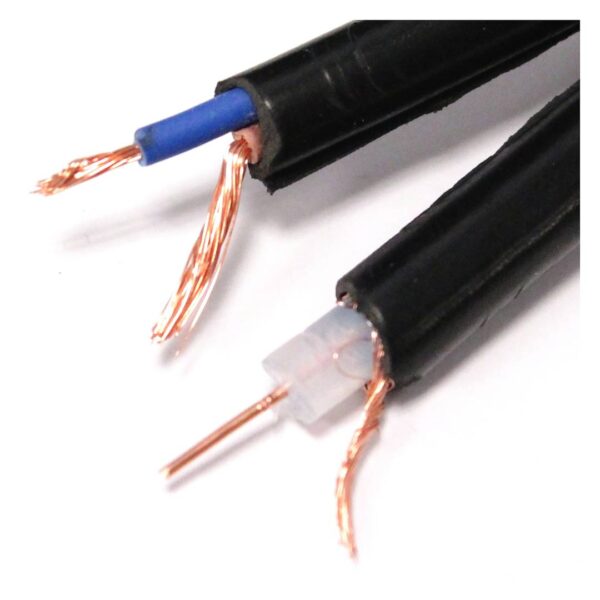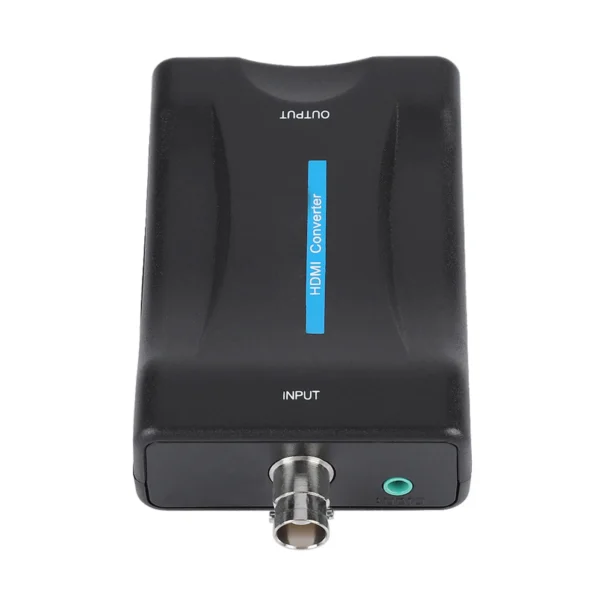| Description |
- Connector Type: BNC (Bayonet Neill-Concelman) for secure connections.
- Construction: Coaxial cable with BNC connectors.
- Shielding: Multiple layers to minimize interference.
- Impedance: Typically 75 ohms for standard video applications.
- Compatibility: Compatible with cameras, monitors, DVRs, etc.
- Applications: Used in surveillance, broadcast, and professional AV setups.
|
- Transmission Medium: Used for analog video transmission.
- Construction: Typically consists of a solid copper or copper-clad steel conductor with insulation and shielding.
- Impedance: 75 ohms impedance, suitable for analog video signals.
- Connectors: Often equipped with BNC connectors for video equipment.
- Compatibility: Compatible with devices using analog video signals.
- Signal Quality: Suitable for analog video but may not be optimal for HD or digital signals due to higher signal loss.
- Applications: Commonly used in older CCTV systems and analog cable television.
These cables are reliable for transmitting analog video signals, particularly in legacy systems, but may not be ideal for modern high-definition video applications. |
- Transmission Medium: Used for cable TV, satellite TV, and broadband internet.
- Construction: Copper or aluminum conductor with insulation and shielding.
- Impedance: Typically 75 ohms for high-frequency signal transmission.
- Connectors: F-type connectors for secure connections.
- Compatibility: Works with TVs, satellite receivers, cable modems, etc.
- Signal Quality: Offers excellent signal quality for HD video and digital audio.
- Flexibility: Available in various lengths for customizable installations.
- Applications: Used in residential, commercial, and industrial settings.
|
- Connects devices with DVI output to devices with VGA input
- Converts digital DVI signals to analog VGA signals
- Allows older VGA-compatible monitors or projectors to be used with newer DVI-equipped computers or devices
- Typically used for displaying video or graphics from a computer to a monitor, projector, or TV
- Provides a simple and cost-effective solution for compatibility between different types of video connections
|
- Long-distance, high-performance signal transmission.
- Multiple layers of shielding for minimal interference.
- Compatible with CATV, satellite TV, and broadband internet.
- Ideal for long-distance data transmission.
|
- Signal Conversion: BNC to HDMI
- Compatibility: Legacy to Modern Displays
- Resolution Support: SD, HD, and 4K
- Audio Integration: Some Models
- Easy Installation: Plug-and-Play
- Use Cases: Surveillance, Broadcast
- Signal Quality: Maintained with High-Quality Cables
|
| Content |
- Connector Type: BNC (Bayonet Neill-Concelman) connectors are commonly used in video applications due to their secure locking mechanism, which ensures a stable connection and minimizes signal loss.
- Construction: BNC video cables typically consist of a coaxial cable with BNC connectors at each end. The coaxial design helps maintain signal integrity by reducing electromagnetic interference.
- Shielding: These cables often feature multiple layers of shielding, including foil and braided shielding, to protect against external interference and ensure high-quality video transmission.
- Impedance: BNC video cables usually have a characteristic impedance of 75 ohms, which is standard for most video applications.
- Compatibility: BNC video cables are widely compatible with various video equipment such as cameras, monitors, DVRs (Digital Video Recorders), and video switchers commonly used in surveillance systems, broadcast studios, and professional AV setups.
- Applications: BNC video cables are commonly used in security and surveillance systems for connecting CCTV cameras to monitors or DVRs. They are also used in professional audiovisual setups for transmitting video signals between different components of a system, such as cameras, video mixers, and displays
| RG59 coaxial cables are a type of communication cable commonly used for analog video transmission. Here's a brief description:
- Transmission Medium: RG59 coaxial cables are primarily used for analog video transmission, commonly found in older CCTV systems, analog cable television, and some residential video applications.
- Construction: These cables typically consist of a solid copper or copper-clad steel conductor surrounded by insulation, a metallic shield, and an outer insulating layer. The shielding helps minimize signal interference and ensures efficient signal transmission.
- Impedance: RG59 cables typically have a characteristic impedance of 75 ohms, which is suitable for analog video signals.
- Connectors: They often feature BNC connectors, which are commonly used for coaxial connections in video applications. BNC connectors provide a secure and reliable connection for video equipment.
- Compatibility: RG59 cables are compatible with devices that use analog video signals, such as older CCTV cameras, analog monitors, and analog video recorders.
- Signal Quality: While RG59 cables are suitable for analog video transmission, they may not be optimal for high-definition (HD) video signals or digital data transmission, as they have higher signal loss compared to newer coaxial cable standards like RG6.
- Applications: RG59 coaxial cables are primarily used in legacy video systems where analog video signals are still prevalent. However, they are gradually being replaced by newer cable standards like RG6 for better signal quality and compatibility with modern video equipment.
Overall, RG59 coaxial cables serve as a reliable transmission medium for analog video signals in various applications, although they may not be suitable for high-definition video or digital data transmission due to their higher signal loss. | RG6 coaxial cables are a type of communication cable commonly used for various audio and video applications. Here's a description of their features and functionality:
- Transmission Medium: RG6 coaxial cables serve as a transmission medium for carrying high-frequency signals, typically used for cable television (CATV), satellite television, and broadband internet connections.
- Construction: These cables consist of a copper or aluminum conductor surrounded by insulation, a metallic shield, and an outer insulating layer. The shielding helps minimize signal interference and ensures efficient signal transmission.
- Impedance: RG6 cables usually have a characteristic impedance of 75 ohms, which is ideal for transmitting high-frequency signals without significant loss or distortion.
- Connectors: They commonly feature F-type connectors, which are threaded connectors designed for secure connections to devices such as TVs, satellite receivers, cable modems, and antennas.
- Compatibility: RG6 cables are compatible with a wide range of audio and video devices that utilize coaxial connections. They are suitable for both indoor and outdoor use, with weatherproof variations available for outdoor installations.
- Signal Quality: Due to their construction and shielding, RG6 cables offer excellent signal quality and are capable of carrying high-definition (HD) video and digital audio signals over long distances without degradation.
- Flexibility: They come in various lengths, offering flexibility in installation and allowing users to customize cable lengths according to their specific needs.
- Applications: RG6 coaxial cables are widely used in residential, commercial, and industrial settings for connecting TVs, set-top boxes, satellite dishes, cable modems, antennas, and other audio/video equipment.
Overall, RG6 coaxial cables provide reliable and efficient transmission of audio and video signals, making them a popular choice for home entertainment systems, telecommunications networks, and broadband internet connections | A DVI to VGA cable serves as a bridge between devices utilizing different video output standards, specifically Digital Visual Interface (DVI) and Video Graphics Array (VGA). DVI is a digital interface commonly found on modern computers, laptops, and other multimedia devices, while VGA is an analog interface that has been prevalent in older monitors, projectors, and displays.
This cable facilitates the connection of a device equipped with a DVI output port to a display or peripheral device featuring a VGA input port. It effectively translates the digital signals outputted by the DVI port into analog signals compatible with VGA input, ensuring seamless compatibility between the two devices.
Typically, the DVI end of the cable plugs into the DVI output port of the source device, such as a computer or DVD player, while the VGA end connects to the VGA input port of the display device, such as a monitor or projector. Once connected, the cable enables the transmission of video signals from the source device to the display device, allowing users to view images, videos, presentations, and other visual content.
This cable is particularly useful in scenarios where users need to connect newer devices with DVI outputs to older displays or projectors that only support VGA input. By providing a straightforward and reliable means of conversion between digital and analog video signals, it eliminates the need for complex adapters or converters, streamlining the setup process and ensuring compatibility without sacrificing video quality.
Furthermore, DVI to VGA cables are often used in various applications, including business presentations, educational settings, home entertainment systems, and professional audiovisual setups. Whether you're connecting a laptop to a classroom projector, a desktop computer to a legacy monitor, or a multimedia player to a TV screen, this cable offers a practical and cost-effective solution for achieving interoperability between different video standards.
In summary, a DVI to VGA cable serves as a versatile and essential tool for connecting devices with disparate video output standards, enabling seamless integration and compatibility in a wide range of multimedia setups and environments. |
- Transmission Medium: Designed for long-distance, high-performance signal transmission.
- Construction: Solid copper or copper-clad steel conductor with multiple layers of shielding for minimal signal loss and interference.
- Impedance: Typically 75 ohms, suitable for various audio, video, and data transmission applications.
- Connectors: Often equipped with F-type connectors for coaxial connections.
- Shielding: Provides high shielding effectiveness, reducing susceptibility to interference and noise.
- Compatibility: Compatible with CATV systems, satellite TV receivers, broadband internet modems, and other coaxial-based equipment.
- Applications: Commonly used in cable television distribution networks, satellite TV installations, high-speed internet connections, and long-distance data transmission setups.
RG11 coaxial cables are preferred for their superior performance and reliability in long-distance communication applications. |
BNC-to-HDMI adapters are connectors designed to convert BNC (Bayonet Neill-Concelman) video signals to HDMI (High Definition Multimedia Interface) signals. Here's a description of their features:
- Signal Conversion: BNC-to-HDMI adapters allow devices with BNC outputs, such as surveillance cameras or professional video equipment, to connect to devices with HDMI inputs, such as modern TVs, monitors, or projectors.
- Compatibility: These adapters bridge the gap between legacy BNC video equipment and modern HDMI displays, enabling seamless connectivity between different types of devices.
- Resolution Support: BNC-to-HDMI adapters typically support various resolutions, including standard definition (SD), high definition (HD), and even some higher resolutions like 4K, depending on the adapter's capabilities.
- Audio Integration: Some BNC-to-HDMI adapters also support audio transmission, allowing both video and audio signals to be converted and transmitted through the HDMI connection.
- Construction: These adapters are constructed with durable materials to ensure reliable signal transmission and longevity.
- Easy Installation: They are typically plug-and-play devices, requiring no additional drivers or software installation. Users can simply connect the BNC end to the device's BNC output and the HDMI end to the HDMI input of the target device.
- Use Cases: BNC-to-HDMI adapters are commonly used in surveillance systems, broadcast studios, and other professional video setups where older BNC equipment needs to be integrated with modern HDMI displays.
- Signal Quality: While adapters themselves do not affect signal quality, it's essential to ensure that the cables used with the adapters are of high quality to maintain signal integrity during transmission.
Overall, BNC-to-HDMI adapters provide a convenient solution for integrating legacy BNC video equipment with modern HDMI displays, offering compatibility and flexibility in various audiovisual setups.
|






















Rating & Review
There are no reviews yet.